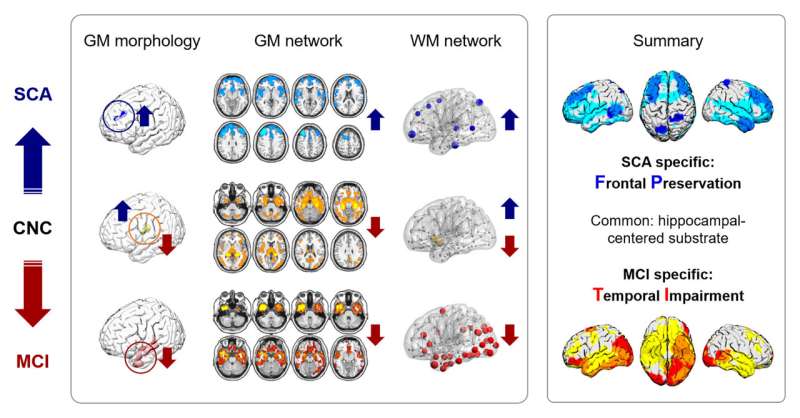Successful or pathological cognitive aging? The 'frontal preservation, temporal impairment (FPTI)' hypothesis

While most individuals experience cognitive decline with increasing age, with some even suffering from pathological cognitive aging like dementia, others can maintain superior cognitive performance, known as successful cognitive aging (SCA). What characterizes the brains of SCA individuals morphologically and what comprises the difference between brain substrates of successful and pathological cognitive aging is largely unknown yet.
In a study published in Science Bulletin, three groups of older adults (aged 70-88 years), including 64 SCA individuals, 68 mild cognitive impairment (MCI) patients, and 66 cognitively normal controls (CNC) were recruited. T1-weighted and diffusion-weighted images were collected and analyzed to compare the brain gray matter (GM) integrity, GM covariance intensity, and white matter (WM) network properties among the three groups.
Compared to the other two groups, the SCA group showed increased GM volume in the left middle frontal gyrus, enhanced GM integrity and covariant intensity of the frontal covariance network, and improved WM network nodal efficiency in the frontal and basal ganglia regions. In contrast, the MCI group had decreased GM integrity and disrupted WM network connections in the temporal-occipital regions.
The hippocampal-centered structure was found both SCA-preserved and MCI-impaired individuals. Moreover, the overlapped GM and WM network maps and their decoding results revealed specific preservation and impairment signatures of successful and pathological cognitive aging respectively.
These results suggest that SCA is accompanied by brain structural preservation in the frontal regions, whereas pathological cognitive aging is accompanied by brain structural impairment in the temporal regions, which led the researchers to propose the "frontal preservation, temporal impairment (FPTI)" hypothesis to explain the neural basis of cognitive aging heterogeneity.
This study was led by Prof. Zhanjun Zhang (State Key Laboratory of Cognitive Neuroscience and Learning, Beijing Normal University) and Dr. Yaojing Chen (State Key Laboratory of Cognitive Neuroscience and Learning, Beijing Normal University).
More information: Yiru Yang et al, Successful or pathological cognitive aging? converging into a "frontal preservation, temporal impairment (FPTI)" hypothesis, Science Bulletin (2022). DOI: 10.1016/j.scib.2022.11.004



















